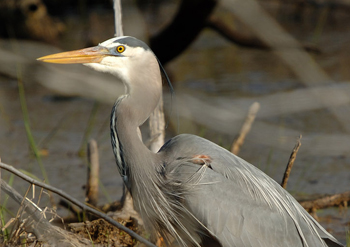
A Lake Michigan colony of great blue herons had elevated levels PFCs, which are chemicals of emerging concern. Photo: Rob Quinn, U.S. NPS
What do cologne and Indiana’s great blue herons have in common?
They both contain chemicals that are increasingly worrisome to Great Lakes officials.
A list of contaminants of emerging concern includes synthetic musks and perfluorinated compounds, or PFCs. Musks are a key ingredient of perfume. PFCs have had a bevy of industrial uses including fire-fighting foams and stain-resistant Scotchgard.
3M Co., once America’s biggest PFC producer, phased out the chemicals in 2003.
It’s reasonable to expect that PFC concentrations will be high near cities and industry, said Thomas Custer, wildlife biologist with the U.S. Geological Survey. So Custer tested eggs from great blue herons in the Indiana Dunes National Lakeshore, which is downwind from Chicago and Gary, Ind.
Custer collected the eggs in 1993 when testing for other contaminants, but pulled them out of the archives in 2007 when concern about PFCs began to grow. The chemicals are stable and shouldn’t have changed since 1993, he said.
The PFC levels in the eggs Custer tested were “comparable to high” relative to other bird species in the area, he said. PFCs accumulate in wildlife, and great blue herons are at the top of the food chain. That makes them vulnerable to PFC buildup.
Chemicals of emerging concern detected in the Great Lakes:
- Synthetic Musks
- Perfluorinated Compounds
- Brominated Diphenyl Ethers
- Other Flame Retardants
- Alkylphenol Ethoxylates
- Chlorinated Paraffins
- Phthalates
- Pharmaceuticals, Veterinary Drugs and Personal Care Products
- Current Use Pesticides
Source: International Joint Commission
So the chemicals are there. But whether that’s a problem is another question.
“We’re just beginning to understand what the ramifications of these chemicals are to wildlife,” he said.
Detecting PFCs in the environment is a new science, so most PFC research doesn’t say much more than, “We measured it here and we measured it there and this is how much we found,” said John Newsted, a scientist with Entrix, an environmental consultant 3M hired to study PFCs. “Other than that, there’s not a lot.”
The effects of PFCs on wildlife are likely to be subtle changes in reproduction or immune systems, Newsted said. High concentrations could cause birds to lay fewer eggs or make eggs less likely to hatch.
While PFCs have been found in Great Lakes fish, birds, frogs, turtles and otters, it’s still not clear that any of these animals are at risk.
“The concentrations in most animals in most cases in the world, including the Great Lakes, are probably below the threshold for effects,” Newsted said.
But Great Lakes officials are still keeping an eye on them. Chemicals of emerging concern like PFCs were one of six hot topics at a recent meeting of the International Joint Commission, a group of U.S. and Canadian scientists and policy advisers dedicated to the Great Lakes.
And the $475 million Great Lakes Restoration Initiative recently signed into law by President Barack Obama includes $12.8 million for monitoring both legacy and new contaminants.
Custer hoped to go back to the Indiana Dunes colony of herons to track trends in PFC concentrations. But park officials told him the birds have trashed their old home and flown the coop for good, he said.
“Those birds destroy their own habitat through time,” he said. “They defecate, get nitrogen in the soil and kill the trees.”